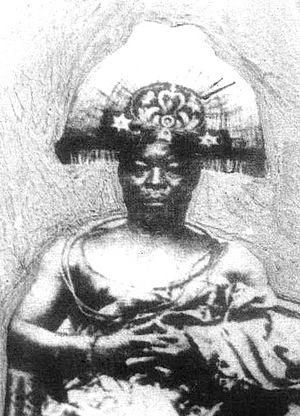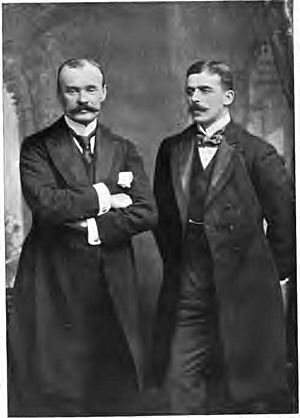Benin Expedition of 1897 facts for kids
Quick facts for kids Benin Expedition of 1897 |
|||||||
|---|---|---|---|---|---|---|---|
| Part of the Scramble for Africa | |||||||
|
|||||||
| Belligerents | |||||||
| Commanders and leaders | |||||||
| Strength | |||||||
| 1,200 | Unknown | ||||||
The Benin Expedition of 1897 was a military action by the British Empire. A British force of 1,200 men, led by Sir Harry Rawson, attacked the Kingdom of Benin. This happened after a group of British officials, led by James Robert Phillips, was ambushed.
Rawson's troops captured and took over Benin City. This ended the independent Kingdom of Benin. It later became part of colonial Nigeria. The expedition also freed some people who were held as slaves by the king.
Contents
Why the British Attacked Benin

In the late 1800s, the Kingdom of Benin was one of the few African kingdoms that remained independent. Many European countries were trying to take control of parts of Africa during a time called the Scramble for Africa.
The ruler of Benin, known as the Oba, controlled all trade in his lands. This was a problem for British trading companies. In 1892, a British official named Captain Henry Gallwey tried to make a trade deal with Oba Ovọnramwẹn Nọgbaisi. The British wanted to trade freely and develop the palm oil industry.
The Oba was not eager to sign the treaty. Even after it was signed, he continued to charge taxes on goods. The British believed this was against the agreement. They saw it as a hostile act.
Some people say the British wanted to stop certain practices in Benin. However, many historians believe the main reason for the British interest was to gain economic control. They wanted to open up Benin for their own trade.
In 1894, after the British captured a trading town nearby, the Kingdom of Benin increased its military presence. British attempts to enforce the treaty in 1895 and 1896 were not successful.
In March 1896, the Oba stopped the supply of palm oil to traders. This stopped all trade in the region. British merchants asked their Consul-General to "open up" Benin. They wanted the Oba, who they felt was blocking their trade, to be removed.
The "Benin Massacre" (January 1897)
In November 1896, James Robert Phillips, a British official, decided to visit the Oba in Benin City. He wanted to discuss the trade agreement. He asked his superiors in London for permission. He also said that the trip would help them get ivory.
However, Phillips did not wait for approval. In late December 1896, he started his journey to Benin City. His group included many British officials, traders, and about 240 African porters and laborers.
Phillips sent a message to the Oba. He said his visit was for trade and peace. But the Oba was celebrating an important festival called Igue festival. He sent word that he was not ready to see the British. He asked Phillips to wait a month or two.
On January 4, 1897, Phillips and his entire group were ambushed. This happened near Gwato, on their way to Benin City. Many British officers and African porters were killed. Only two British men survived: Alan Maxwell Boisragon and Ralph Locke.
News of this attack, which became known as the 'Benin Massacre', quickly reached London. This event led Britain to plan a military response. British officials said it was important to show that "white men cannot be killed with impunity."
The Punitive Expedition (February 1897)
On January 12, 1897, Rear-Admiral Harry Rawson was chosen to lead a British force. His mission was to invade the Kingdom of Benin and capture the Oba. This operation was called the Benin Punitive Expedition.
The invasion began on February 9, 1897. The British force had about 1,200 Royal Marines, sailors, and soldiers from the Niger Coast Protectorate. They were divided into three groups. British warships and gunboats approached Benin City from different directions.
After ten days of fighting, two of the British groups reached Benin City. The third group followed the same path as Phillips's earlier mission. They found the scene of the massacre.
On February 18, Benin City was captured by the British. The city was set on fire. Some say this was an accident. Eight British soldiers were killed during the expedition. The number of Benin people killed, both soldiers and civilians, was not counted. However, it is believed to have been very high.
The expedition was very quick. In less than a month, the British force was gathered, transported, and ready. Five days later, Benin City was taken. In another twelve days, the soldiers were back on their ships.
What Happened Next
After Benin City was captured, many buildings were looted. These included houses, sacred places, and the Oba's palace. Many buildings were also burned down.
The Oba was later captured by the British consul-general, Ralph Moor. He was removed from power and sent away to Calabar with two of his wives. The British appointed a new leader. Six chiefs were executed in Benin City's marketplace.
Most of the valuable items taken from the city were kept by the expedition. About 2,500 religious objects, artworks, and historical items were sent to Britain. These included over a thousand metal plaques and sculptures, now known as the Benin Bronzes. The British Navy sold many of these items to help pay for the expedition.
About 40% of the art went to the British Museum. Other pieces were given to British soldiers. The rest were sold at auctions. Many of these Benin Bronzes were bought by museums, especially in Germany. The spread of Benin art around the world helped Europeans see the value of West African art in a new way. This art also influenced many European artists and helped shape early modernism in Europe.
The British took control of Benin. It became part of the Niger Coast Protectorate and later colonial Nigeria. After the British took over, slavery was ended. However, the British also made local people work as forced laborers. Their conditions were often very poor.
Returning Looted Objects
In recent years, there has been a movement to return the objects taken from Benin.
In 2017, a rooster statue called an okukor was removed from a college in Cambridge, England. Students protested that it should be returned to Nigeria. On October 27, 2021, the okukor was officially returned to Nigeria's National Commission for Museums and Monuments.
The University of Aberdeen in Scotland was the first to agree to fully return a Benin Bronze from its museum. In March 2021, they handed back a bronze sculpture of an Oba's head to Nigeria. The university had bought it at an auction in 1957.
Today, the Nigerian government's policy is that all returned Benin Bronzes belong to Ewuare II. He is the current Oba of Benin and a direct descendant of the ruler overthrown in 1897. This policy has caused some debate. Many descendants of the freed slaves still live in the Benin area.
Cultural Works About the Expedition
- Plays about these events include Ovonramwen N' Ogbaisi by Ola Rotimi (1971) and The Trials of Oba Ovonramwen by Ahmed Yerima (1997).
- Visual artists have responded with works like Tony Phillips' series of prints, History of the Benin Bronzes (1984).
- Films covering parts of the expedition include The Mask (1979) and Invasion 1897 (2014).
|
See also
- History of Nigeria
- Izevbokun Oshodin






